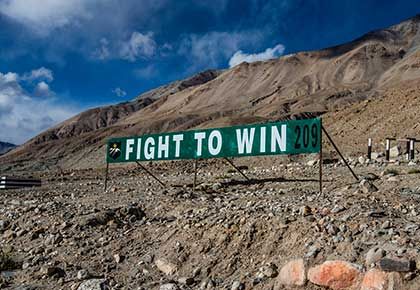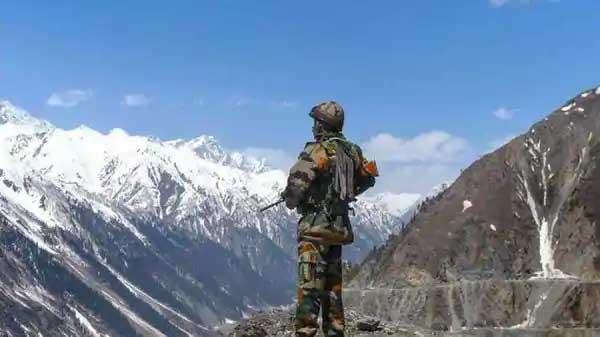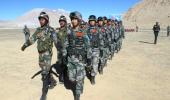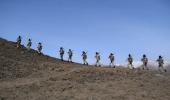General Zhao Zongqi is well known in India for having commanded the Chinese troops during the Dokalam episode.
Zhao knows every inch and corner of the Indian border, at least the Eastern and Central sectors, including the Naku La area which witnessed fist-fights between Indian and Chinese troops in April/May.
Claude Arpi introduces us to the PLA generals masterminding the Chinese aggression in Ladakh.

Two days after Lieutenant General Harinder Singh, the 14 Corps Commander of the Indian Army, met Major General Liu Lin, commander of the South Xinjiang Military District (SXMD) of the Chinese People's Liberation Army at Moldo near the Line of Actual Control to discuss the dispute along the LAC in Eastern Ladakh, The Global Times said: 'The ongoing border dispute between China and India will not escalate into a conflict or another Doklam standoff after military commanders from both sides held talks that resulted in positive agreements on peacefully resolving the situation.'
Quoting Chinese foreign ministry officials and 'experts', the tabloid added: 'However, due to the complexity of the situation, the military standoff could continue for a little longer.'
Interestingly, it gave the Chinese motivations: 'China-India border tensions flared up after India recently illegally constructed defense facilities across the border into Chinese territory in the Galwan Valley region.'
Is it not strange that China should object to Delhi building infrastructure on India's side of the LAC, when China has done this for decades on the Tibetan plateau?
Whether it is China's official rationale for bringing thousands of troops and equipment in an area once described by an Indian prime minister as 'a place where not a blade of grass grows', other 'internal' reasons are behind the Chinese move, in particular the post-COVID-19 economic situation in China, during which China's supreme leader Xi Jinping might be questioned within the Chinese Communist Party on the way he had handled the spreading of the virus.
The PLA Factor
However, an important factor for China's present diplomatic and military belligerence is linked to the crucial role played by the PLA during the most contagious phase of the COVID-19 spread.
There is no doubt that the PLA played a vital role; Xi Jinping later asserted that the Chinese army must step up combat readiness: 'It is necessary to step up preparations for armed combat, to flexibly carry out actual combat military training, and to improve our military's ability to perform military missions.'
The PLA has already acted in the South China Sea, Sikkim and Ladakh
The present incursions in Ladakh should be seen in this perspective; the PLA needed to be given a training field and even if it is not the only reason for the present intrusions, it is undoubtedly a crucial factor.
In this context, the recent changes in the Western Theater Command (WTC) dealing with the Indian border are worth looking at.

Let us go back a few years in history.
In 2016, the PLA established five theater commands as part of the military reforms dear to Xi Jinping; the same year, an article in The Global Times reported that the Tibet Military District (TMD) under the WTC was responsible 'for operations against India, at least in the Arunachal Pradesh area, training forces for specialised high-altitude mountain warfare and long-range mobility for such a contingency.'
In 2018, it was announced that the Tibet Military District had been elevated by one level compared to other provincial-level military districts and placed under the PLA Army (or Ground Force PLAGF).
The Xinjiang Military District (XMD) also came under the PLAGF command.
'The current reforms and reorganisation make the services responsible for force development and training their respective forces, which would appear to include the Army commands in the Tibet and Xinjiang Military Districts,' commented the Jamestown Foundation's China Brief.
What is going on in the Western Theater Command?
On December 13, 2019, as the coronavirus had started spreading in Wuhan, Xi Jinping -- who is chairman of China's Central Military Commission in addition to being general secretary of the Chinese Communist Party and president of the People's Republic of China -- promoted seven lieutenant generals to the rank of full general ('Three Stars').
One of them, Lieutenant Generals He Weidong was transferred on promotion as commander of the Eastern Theater Command (ETC), equivalent to an army commander in India.
The fact that General He was commander of the WTC Ground Force (GF) shows the importance of the post.
In this perspective, it is extremely surprising that the post that General He vacated in December remained 'vacant' for more than five months.
By the end of April, around the time the Ladakh build up started, a new commander for the WTC's PLAGF was appointed; some Chinese blogs announced that Lieutenant Generals Xu Qiling had taken over.
Had General Xu been brought in to coordinate the fronts in Sikkim and Ladakh? In all probability, yes!
What is interesting is that Gen Xu Qiling also served for a long time in the Jinan Military Region before being transferred as commander of the 83rd Group Army in the Central Theater Command.
On December 11, 2019, he was awarded the military rank of lieutenant general by Chairman Xi.
Like General He, he was a delegate at the recently held 13th National People's Congress.
The Boss: General Zhao Zonqi
The WTC Commander, General Zhao Zongqi, is well-known in India for having commanded the Chinese troops during the Dokalam episode.
Most importantly, General Zhao served 20 years in the Tibet Military District.
He knows every inch and corner of the Indian border, at least the Eastern and Central sectors, including the Naku La area which witnessed serious fist-fights between Indian and Chinese troops in April/May.
The 2016 PLA restructuring had an interesting feature, the former Military Regions (MRs) of Chengdu and Lanzhou were regrouped, which means the entire Indian border thereafter came under one single command and not two as before.
One can see that the present operations in Ladakh or Sikkim (and Arunachal if necessary) can be synchronized under one command (under General Zhao Zongqi); it is a formidable advantage.

The Jinan Clique?
Where was General Zhao Zongqi before taking over the WTC?
From 2012 to 2016, he was commanding the Jinan Military Region.
But it is not all.
Gen Xu Qiling's counterpart in the PLA Air Force is Lieutenant General Wang Qiang.
Though already a full-time deputy commander of the WTC, he has been given additional charge of commander of the WTC PLA Air Force (PLAAF) since May 8.
He earlier served as a division commander of the Air Force Aviation Division of the Jinan Military Region, and deputy chief of staff of the air force, also in Jinan; in 2016, he followed his boss in the WTC.
There is clearly a Jinan Clique on the frontiers of India.
Another New Commander
Lieutenant General Xu Yong, who had been commanding the Tibet Military District for the past seven years, retired in January. Lieutenant General Wang Haijiang has taken over his responsibilities. He too knows the border well.
In 2013, General Wang was posted as the deputy commander of the South Xinjiang Military District which exercises frontline responsibility and jurisdiction over the Hotan and Ngari Military Sub-Districts. Eastern Ladakh comes under the Hotan Military Sub District.
In April 1987, China's Central Military Commission had established the 'Southern Military Command of the Chinese People's Liberation Army' under the Xinjiang Military District (XMD).
The South Xinjiang Military District itself is based in Kashgar while the XMD is located in Urumqi.
General Wang held this position until 2016, when he was appointed XMD deputy commander.
On December 10, 2019, Gen Wang became a lieutenant general.
Like General He Weilong and General Xu Qiling, he recently attended the 13th National People's Congress in Beijing.

Major General Liu Lin
The present commander of the South Xinjiang Military District is in the news after his meeting with Lieutenant General Harinder Singh, the 14 Corps Commander.
On November 4, 2016, it was announced that the role of the South Xinjiang Military District was to be 'stationed on the northwestern border of the motherland, guarding more than 900,000 square kilometers of the territory of the People's Republic as well as the borderline of more than 3,500 kilometers.'
General Liu Lin was promoted to the rank of major general in January 2015 and was transferred as Deputy Commander of the South Xinjiang Military District the same year. He became Chief of Staff of the South Xinjiang Military District.
In 2019, the PLA media revealed that General Liu had been promoted to commander of the military district overlooking the Western Himalayan borders.
In an interview published in CCTV's Military Report, General Liu explained: 'President Xi requires that the soldiers be trained first, and the strong army first needs strong officers. ...(if this is done), we will better grasp the actual combat training of the troops. ...a good team leader, it's not enough to stand at the top of the line, and more importantly, we must set up first-class standards.'
Major General Liu Geping
Other changes have taken place.
Most of the time, it shows that experience on the Indian border pays for promotion.
Take Major General Liu Geping who has been promoted commander of the Qinghai Military District. He commanded the Chinese troops during the major intrusions in April 2013 in the Depsang Plains, just before Chinese Premier Li Keqiang's visit to India and in September 2014 in Chumar in Ladakh as Xi Jinping arrived in Ahmedabad.
Then a Senior Colonel, Liu Geping was commanding the Ngari (Ali) SMD, he was responsible for areas such as Chushul, Pangong tso, Demchok, Chumar and Shipkila Pass.
A Chinese Web site mentioned: 'In early September 2014, Liu Geping received an order to force the troops to go to a certain area in the No 6 area and perform a training exercise called 'Operation Hurricane'.'
It refers to the intrusions in the Chumar sector in Ladakh, which were repelled by India.
Lieutenant General Liu Wanlong
Another case is Liu Wanlong.
In February 2008, Liu was appointed commander of the Ngari (Ali) MD, facing Northern India.
In 2011, he was transferred and posted as deputy commander of the SXMD.
On March 17, 2014, Liu went to the Gansu MD as an 'adjustment'.
It was the time when heads had started rolling in the PLA. Ultimately, between 100 and 200 major generals and above would be 'investigated' and would lose their jobs.
'Adjustment' became routine in the senior ranks of the PLA.
In January 2017, Liu was transferred to the Xinjiang MD as its commander, directly under General Zhao Zongqi.
All this shows that all the generals involved in the Ladakh imbroglio are either 'faithful' to General Zhao who is bidding for a promotion as a member of the Central Military Commission (the 'paradise' for a Chinese general) or have been serving for years on the Indian borders like General Zhao himself.
It means that the standoff may last for a few months. General Zhao needs to 'merit' his promotion, his junior colleagues too are aware of what the Ladakh standoff means for their career.























